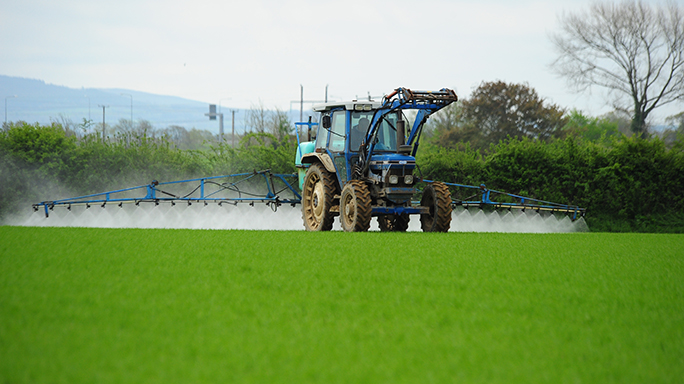Autumn Herbicide Options for 2017

Over the last number of years the traditional autumn herbicide for winter cereals has been based on a post-emergence application combined with an aphicide for the control of Barley Yellow Dwarf Virus (BYDV).
With the registration of IPU revoked on the 30th September 2016, and the use up period expiring 12 months later, for most crops IPU will no longer be an option. Autumn herbicide strategy will now be based on a pre-emergence or early post emergence application. For later sown crops in November/December, herbicide application can be delayed until early spring, particularly on winter wheat. The increase in the use of Redigo Deter seed dressing will facilitate the use of a pre emergence herbicide application.
Pre emergence weed control as the name suggests, is applied before both the crop and the weed has emerged, and is usually applied shortly after drilling and rolling of the ground. Control is based on residual modes of action which are reliant on good firm seed beds and soil conditions for application. Field history is also vital to know what your target weeds are.
Post emergence herbicides are applied following crop emergence, with some but not all weeds emerged. Control is based on a combination of both residual and contact modes of action. Weeds present within the crop and can be identified which will aid product choice. However, post emergence control can often be difficult of certain weed species, particularly if they are advanced. Weed control can be impacted by thick crop canopies while low temperatures can impact on the efficacy of herbicides with contact modes of action.
For winter cereals, the biggest threat to crop yields in recent years, have been the influx of grass weeds, and in particular Sterile and Soft Brome which has been exasperated by poor control in recent seasons. Control of Brome’s and other grass weeds is very much an integrated approach, including stale seed beds, good ploughing and rotations, followed up with chemical control. For best results, the use of herbicides pre-emergence is advised as opposed to post emergence. In wheat and barley, barren brome tends to be most effectively controlled by autumn applications, provided weather and soil conditions are conducive to herbicide activity.
When it comes to winter wheat, ALS-inhibiting products alone, can be very effective in terms of grass weed control. These are only cleared for application on winter wheat. Products include Alister Flex and Pacifica Plus. However, particularly with high grass weed populations, a programme including a pre- or early post emergence herbicide in sequence with an ALS-inhibiting product is more reliable. In terms of winter barley, the most effective programmes have tended to feature flufenacet at a pre- or early post-emergence timing, where there is no option for the use of ALS-inhibiting products. Management of bromes and grass weeds can be more difficult in winter barley. Autumn pre- or early post-emergence approaches can be used and supplemented in stacks or sequences with chlorotoluron (check variety susceptibility) or an additional dose of flufenacet, typically as a sequence. Pre-emergence herbicides will also offer the grower good broad leaf weed control. With the loss of IPU, pre-emergence herbicides will now become a matter of course as opposed to a matter of choice on winter barley.
Options include:
Defy (800g Prosulfocarb) – Used at 2.0/ha in combination with 0.1/ha of DFF. Pre-emergence application only in winter barley. Offers excellent annual meadow grass and cleaver control. Can only be used up to growth stage 21.
Firebird/Navigate (400g Flufenacet, 200g Diflufenican) – excellent residual on annual meadow grass and other grass weeds. Used in the past in combination with IPU at early post-emergence. Best result from pre-emergence or peri-emergence application. For brome situations, can be used in sequence with a second application. User rate of 0.3/ha both pre and post emergence application
Flight (330g Pendimethalin, 7.5g Picolinafen) – best result from pre-emergence application but can be used post emergence. High user rate, delivering 1320g of PDM/Ha at 4.0/ha. High user rate and staining issue does not make it the most user friendly product.
Tower (40 g/l Diflufenican, 300 g/l Pendimethalin, 250 g/l Chlorotoluron) – A releatively new product to the Irish market. Can be used in either a pre or post emergence situation in both winter wheat or barley. There are some varietal restrictions in the UK, but recent trials indicate no issue with current recommended list varieties. Will control very young grasses but best results for pre-emergence application. Very good broad leaved weed control along with grass weed activity.
Vigon (60 g/l Diflufenican, 120 g/l Flortamone, 240 g/l Flufenacet) – Similar to Firebird, offers very good residual grass and broad leaved weed control in winter wheat and barley. Reduced rate of 0.5/ha only oermitted in winter barley.
Alister Flex (120 g/l Diflufenican, 9 g/l Mesosulfuron-methyl, 7.5 g/l Iodosulfuron-methyl-sodium)
Winter wheat only product. Improved formulation offers increased broad leaved weed control. Excellent contact action on grass weeds. Generally used in late autumn or early spring application.
Pacifica Plus (30 g/kg Mesosulfuron-methyl, 10 g/kg Iodosulfuron-methyl-sodium, 50g/kg Amidosulfuron) – Winter wheat only product Post emergence product offering excellent contact control of grasses and bromes. New formulation offers improved control of cleavers. Can be hard on the crop and tank mix restrictions apply.
Broadway Star (7.1% w/w Pyroxsulam, 7.1% Cloquintocet-mexyl, 1.4% w/w Florasulam). Winter wheat only product offering very good control of bromes and grass weeds. Needs to be used in a programme with PDM for annual meadow grass control. Best control of bromes when applied on the young growing plant.
David Cooney, Tillage Business Manager, Glanbia Agribusiness
First Published 27 September 2017
Tagged with: Tillage